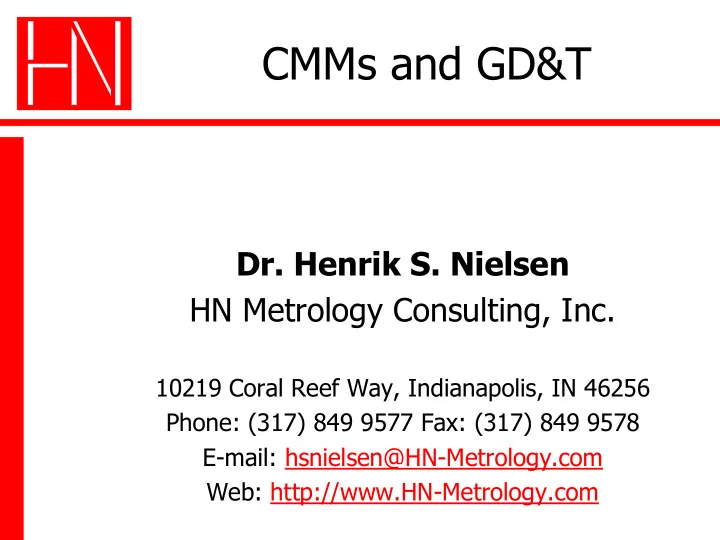

CMMs and GD&T Dr. Henrik S. Nielsen HN Metrology Consulting, Inc. 10219 Coral Reef Way, Indianapolis, IN 46256 Phone: (317) 849 9577 Fax: (317) 849 9578 E-mail: hsnielsen@HN-Metrology.com Web: http://www.HN-Metrology.com
The History of Tolerancing (abbreviated) • Initially there was linear +/- tolerancing – did not capture geometric relationships – did not assure assemblability • Then came Geometrical Dimensioning and Tolerancing – Standardized in ANSI/ASME Y14.5 and ISO 1101 – captures geometric relationships – ensures assemblability
The Scope of GD&T • Claims to cover part function – But the only function covered is assembly
Philosophies of GD&T • Only concerned with Pass or Fail – An actual value is only defined for simple call-outs • such as form deviation – For features referenced to datums all features must be considered simultaneously to determine pass or fail • Actual value is not defined and non-existent
What GD&T Does Well • Tolerancing for assembly – Properly used GD&T can ensure assemblability • Interference avoidance – GD&T controls the extreme points in features • Enable tolerance stackup calculations – By capturing geometrical relationships
What GD&T does not do well • Sealing interfaces • Interference fits • Adaptable (non-stiff) parts • Hydrodynamic interfaces • Roller bearings
Sealing Interfaces • Fuel Injectors – Ensure sealing – Avoid scuffing
Interference Fits • Controlling the location of a pin pressed in a hole
Adaptable (non-stiff) Parts • Piston rings in liners – Ring can adapt to long undulations in liner • but not to short undulations
Hydrodynamic Interfaces • Sliding bearings – Contact is avoided by: • Oil film • Elastic deformation – Some form errors can be tolerated others cannot
Roller bearings • Lobing relative to number of rollers – Vibration – Noise – Longevity
So What About CMMs? • CMMs (or other discrete point measuring machines) can characterize all these examples – By mapping the surface – By breaking the surface down into various wavelength components – By finding average substitute features
The Cost of Tolerances • Cheap: • Expensive: – Stationary, non- – Bearing interference fit • Roller • Sliding – Seal – Piston/Liner
CMMs and GD&T • CMMs can only measure discrete points – usually the operator only takes very few points • e.g. 5-10 points to describe a hole • CMMs usually use least squares algorithms to find substitute features – these are used to represent the real features • This is not in accordance with the definitions given in GD&T standards
So Why Do We Use CMMs? • GD&T is only aimed at the pass/fail decision • Measurement data is needed for several other purposes – Calibration – Tolerance development – Process control – Process capability • CMMs can provide variable data for these purposes
What do CMMs do well? • CMMs work best, when several points are averaged in a result, such as: – Position • e.g. of the center of a hole – Distance • e.g. between hole centers or from a hole center to a plane – Orientation • e.g. angle between two planes
What are CMMs not good at? • CMMs do not work very well for measurements, where the result is dependent on a single point, such as: – Form measurement • e.g. roundness of a hole – Finding datums based on extreme points
Process Control (Feed Back Loop) • What information is needed? – Position(s) – Distance(s) – Actual values – Individual features • What is good control data? – Based on stable algorithms • not sensitive to single point deviations
Process Control Data
Conclusions I • CMMs are very useful tools – Even though they do not measure in accordance with GD&T • Often the difference can be expressed as an uncertainty – CMMs can provide useful information for • Calibration • Tolerance development • Process control
Conclusions II (The Future of Tolerancing) • GD&T needs further development – Handling other functions than fit • There is work going on in ISO in this direction – Next generation GD&T will be a much richer language enabling designers to express functional requirements more precisely • CMMs will handle many of these functions better than they handle current GD&T – because these functions are not based on extreme points
Recommend
More recommend